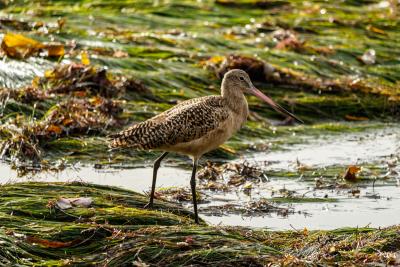As shoreline erosion worsens with rising sea levels, California Sea Grant-funded researchers are trying to find the best approaches to fight the erosion and restore land along California’s coast.
One tactic: create living shorelines for protection.
By restoring native habitats with plants, rocks and sea life, these living shorelines stabilize coasts and simultaneously bolster biodiversity. California Sea Grant and the California State University Council on Ocean Affairs, Science & Technology (COAST) are funding a research project to help develop the best approaches for this restoration effort.
Beds of native oyster and eelgrass meadows, for example, might work well together. They both trap and stabilize shore sediments and allow fish and shellfish to thrive by providing shelter and food. But there’s a risk that they could also hinder each other, negating their potential impact.
This group of researchers is working to figure out if oysters and eelgrass are a dynamic duo or a double-edged sword.
Living shorelines: new solution to an old problem
The question of how shorelines can be protected from erosion isn’t a new one. In 1784, the nation’s first concrete seawall was built in Boston Harbor, Massachusetts. Since then, seawalls have been erected along many coasts, but concerns are growing that the wave energy that these walls deflect often leads to increased erosion further down the shore.
Recent research has shown that natural habitats might be a better solution to make coasts resilient, with the added benefit of enhancing ecosystems. In Mobile Bay, Alabama, experimental breakwater reefs made from loose oyster shells mitigated shoreline retreat by more than 40%.
In California, wild oyster beds and eelgrass meadows have mostly disappeared since the 1900s through pollution, overharvesting, and an outbreak of wasting disease in eelgrass populations in 2010. Efforts have been made to bring these two species back, but much is still unknown about the best ways of doing so.

Photo credit: iStock
How oysters and eelgrass can fight coastal erosion
Theoretically, both oysters (Ostrea lurida) and eelgrass (Zostera marina) should benefit from being around each other. Oysters filter disease-causing organisms from the water that would otherwise harm eelgrasses. And the plants use up carbon dioxide in the sea, making it less acidic and easier for oysters to build their shells.
On the other hand, oyster reefs can also usurp space from eelgrass beds. The grass’s famed ability to calm waves and let sediments settle might also be fatal for oysters as the excess mud could clog up their gills.
The new COAST and California Sea Grant-funded study tries to untangle these effects. Led by Danielle Zacherl of California State University Fullerton, it uses an ongoing project involving eight eelgrass and eight oyster beds that were restored along Upper Newport Bay in Southern California. Some were restored separately and others were revived jointly.
The $390,165 project was selected along with two others on sea level rise through COAST’s State Science Information Needs Program. COAST provided $800,000, and California Sea Grant contributed an additional $300,000 for a total of $1.1M in research funding.
So far, the project has found that combining eelgrass and oysters can indeed be a double-edged sword.
Early results show that eelgrass might act as a bodyguard for oyster beds by absorbing the high-energy waves from boats that could otherwise damage the mollusks’ reefs. In return, being closer to more oysters was accompanied by more eelgrass growth below-ground.
On the other hand, while eelgrass did not deposit sediment onto oyster beds, in some places it still reduced the biomass and condition of the oysters.
Over the next year, the research team hopes to determine the best strategies on how these two shore-saving species can establish and monitor living shorelines.
About California Sea Grant
NOAA’s California Sea Grant College Program funds marine research, education and outreach throughout California. Headquartered at Scripps Institution of Oceanography at the University of California San Diego, California Sea Grant is one of 34 Sea Grant programs in the National Oceanic and Atmospheric Administration (NOAA), U.S. Department of Commerce.